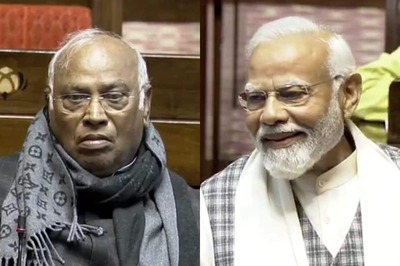
views
New Delhi: The Union Human Resource Development (HRD) ministry has decided to merge its three flagship education development programmes — Sarva Shiksha Abhiyan (SSA), Rashtriya Madhyamik Shiksha Abhiyan (RMSA) and Scheme of Restructuring and Reorganisation of Teacher Education (STE) — starting this new academic year.
The proposal for the new structure will be presented to the Cabinet soon. Meanwhile, News18 has accessed the highlights of the new proposal, which focuses on a holistic approach to education for students from class 1-12.
“The merging of three schemes is an important step because so far, we have looked at school education in a segmented manner. We want to provide a continuum to pursuing school education from pre-primary to class 12th,” said a source within the ministry.
Before coming up with this new initiative, MHRD and school education secretaries from various states held a meeting where they reached a consensus.
“It was agreed by all to merge the SSA, RMSA and STE as it gives them the much-needed flexibility to use resources according to their learning outcomes. For instance, Kerala has excellent primary school education if they want to put money in secondary education they can do it without battling segment and compartments defined by policies,” added the source.
FOCUS ON QUALITY EDUCATION
“The new scheme is envisaged to bring in a holistic approach and administrative reforms, with the single and unified structure leading to harmonised implementation. One of the major hurdles of having segments in schemes was that there was no flexibility in utilising funds from one segment to another. Now they will be free to use the funds in the areas of education that need it,” said the HRD source.
With a focus on quality education, the new scheme has proposed “outcome-oriented allocation of resources and emphasis on learning”.
The minister official further said that teacher education institutes like SCERTs and DIETs will improve the quality of prospective teachers in the system. The new scheme encourages “composite school grant for all schools based on the enrolment”.
State Council of Educational Research and Training has been proposed as the nodal institution for in-service and pre-service teacher training. DIKSHA would be a digital portal to be used extensively for upgrading the skills of teachers, providing open, modular and scalable technology that state governments and other organizations can seamlessly integrate with their respective teacher-centric initiatives. There will also be an annual grant per school for strengthening libraries.
“All this should make teacher training dynamic and need-based,” added the source.
DIGITAL EDUCATION
The new scheme is going to focus on supporting operation digital board, enhanced use of technology in education through smart classrooms, digital boards and DTH channels. Digital initiatives Shala kosh, Shagun, Shaala Saathi would be also strengthened. ICT infrastructure in schools from upper primary to higher secondary level would further be given a boost.
CONSOLIDATION OF SCHOOLS
The new merger of schemes is going to lay emphasis on consolidation of schools for quality improvement. Transport facility to children from class 1-12 to provide universal access and increased allocation for infrastructure strengthening in schools. Under the new scheme, the government is extending exposure to vocational skills to upper primary level as well and strengthening vocational training at secondary level. Also, sports equipment would be provided schools under this component.
EMPOWERMENT OF GIRLS
In a major boost to girls’ education, there will be self-defence training for girls from upper primary to higher secondary. There will be a stipend to be provided for CWSN girls from classes 1-12. One of the important changes is expected to take place in the “Kasturba Gandhi Balika Vidyalaya scheme”, which was introduced by the Government of India in August 2004, and integrated in the Sarva Shiksha Abhiyan program to provide educational facilities for girls belonging to Scheduled Castes, Scheduled Tribes, Other Backward Classes, minority communities and families below the poverty line in Educationally Backward Blocks.
Under the new scheme, there will be "upgradation of KGBVs from class VI-VIII to up to class XII".




















Comments
0 comment